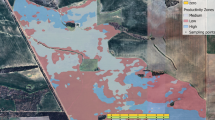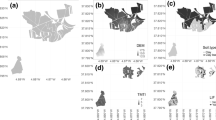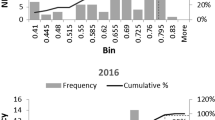Abstract
Profitability analyses of site-specific nitrogen (N) management strategies have often failed to provide satisfying reasons for adoption of precision farming technologies. However, effects of precision farming on product quality and price premiums, as well as on downside risk mitigation, are generally not taken into account. This study aimed to evaluate the comparative advantages of site-specific N management over uniform N management considering N supply on grain quality, and accordingly price premiums for wheat from a downside risk point of view. A virtual field was modelled with two subfields representing two distinctive yield zones to investigate how consideration of grain quality affects the economic potential of site-specific N management under temporally varying N mineralization and changing price patterns of wheat. Moreover, the extent was investigated to which site-specific N management can have a risk-reducing effect on economic shortfalls compared to uniform N management. Two site-specific N management options were assessed: variable N rate application using yield mapping and N sensor for real-time proximal sensing. Results indicated that even though crop yields were only slightly higher, higher expected protein contents of grains could be achieved with site-specific N management options compared to uniform N management. Baking wheat quality was secured to a greater extent with site-specific N management options. Higher average grain quality improved the economic benefits due to price premiums. A risk-reducing effect was observed with the site-specific N management by maintaining the baking wheat quality with a higher probability. Higher economic returns mostly compensated the additional costs for the precision farming technologies in the lower tail of the probability distribution and, thus, site-specific N management did not show any substantial disadvantage on downside risk as compared to uniform N management.





Similar content being viewed by others
References
Anselin, L., Bongiovanni, R., & Lowenberg-DeBoer, J. (2004). A spatial econometric approach to the economics of site-specific nitrogen management in corn production. American Journal of Agricultural Economics,86(3), 675–687. https://doi.org/10.1111/j.0002-9092.2004.00610.x.
Bachmaier, M., & Gandorfer, M. (2009). A conceptual framework for judging the precision agriculture hypothesis with regard to site-specific nitrogen application. Precision Agriculture,10(2), 95–110.
Berg, E. (2003). Modelling the impacts of uncertainty and attitudes towards risk on production decisions in arable farming. In Paper presented at the 25th International Conference of IAAE. Retrieved March 24, 2018 from http://www.ilr.uni-bonn.de/pe/publication/Publikationen/IAAE2003_BE.pdf.
Berg, E., & Starp, M. (2006). Farm level risk assessment using downside risk measures. In Contributed paper prepared for presentation at the 26th International Conference of the IAAE.
Bongiovanni, R. G., Robledo, C. W., & Lambert, D. M. (2007). Economics of site-specific nitrogen management for protein content in wheat. Computers and Electronics in Agriculture,58(1), 13–24. https://doi.org/10.1016/j.compag.2007.01.018.
Boyer, C. N., Wade Brorsen, B., Solie, J. B., & Raun, W. R. (2011). Profitability of variable rate nitrogen application in wheat production. Precision Agriculture,12, 473–487.
Bullock, D. S., Lowenberg-DeBoer, J., & Swinton, S. M. (2002). Adding value to spatially managed inputs by understanding site-specific yield response. Agricultural Economics,27(3), 233–245. https://doi.org/10.1016/S0169-5150(02)00078-6.
Colaço, A. F., & Bramley, R. G. V. (2018). Do crop sensors promote improved nitrogen management in grain crops? Field Crops Research,218, 126–140.
Diacono, M., Rubino, P., & Montemurro, F. (2013). Precision nitrogen management of wheat. A review. Agronomy for Sustainable Development,33, 219–241.
Dillon, C. R., Stombaugh, T. S., Kayrouz, B. M., Salim, J., & Koostra, B. K. (2007). An educational workshop on the use of precision agriculture as a risk management tool. In Stafford, J.V. (ed.), Precision Agriculture ‘07, The 6th European Conference on Precision Agriculture. Wageningen Academic Publishers, 861–867.
Ellmer, F., Erekul, O., & Köhn, W. (2001). Einfluss langjährig differenzierter organisch-mineralischer düngung auf den ertrag, die Ertragsstruktur und die Backqualität von Winterweizen. Archives of Agronomy and Soil Science,47(5–6), 423–444. https://doi.org/10.1080/03650340109366226.
Erekul, O., Ellmer, F., Köhn, W., & Öncan, F. (2005). Einfluss differenzierter Stickstoffdüngung auf Kornertrag und Backqualität von Winterweizen. Archives of Agronomy and Soil Science,51(5), 523–540.
Fiez, T. E., Miller, B. C., & Pan, W. L. (1994). Winter wheat yield and grain protein across varied landscape positions. Agronomy Journal,86(6), 1026–1032.
Finger, R. (2013). Expanding risk consideration in integrated models—the role of downside risk aversion in irrigation decisions. Environmental Modelling & Software,43, 169–172.
Gandorfer, M., & Meyer-Aurich, A. (2017). Economic potential of site-specific fertiliser application and harvest management. In S. M. Pedersen & K. M. Lind (Eds.), Precision Agriculture: Technology and Economic Perspectives (pp. 79–92). Cham: Springer International Publishing.
Gandorfer, M., Pannell, D. J., & Meyer-Aurich, A. (2011). Analyzing the effects of risk and uncertainty on optimal tillage and nitrogen fertilizer intensity for field crops in Germany. Agricultural Systems,104(8), 615–622.
Gandorfer, M., & Rajsic, P. (2008). Modeling economic optimum nitrogen rates for winter wheat when inputs affect yield and output-price. Agricultural Economics Review,9(2), 54.
Griffin, T., & Lowenberg-DeBoer, J. (2005). Worldwide adoption and profitability of precision agriculture: Implications for Brazil. Revista de Política Agrícola,4(4), 20–37.
Griffin, T. W., Shockley, J. M., & Mark, T. B. (2018). Economics of precision farming. In D. K. Shannon, D. E. Clay, & N. R. Kitchen (Eds.), Precision agriculture basics (pp. 221–230). Madison: American Society of Agronomy, Crop Science Society of America, and Soil Science Society of America.
Hanff, H., & Lau, H. (2016). Datensammlung für die betriebswirtschaftliche Bewertung landwirtschaftlicher Produktionsverfahren im Land Brandenburg. Schriftenreihe des Landesamtes Ländliche Entwicklung, Landwirtschaft und Flurneuordnung, Frankfurt (Oder), 7(1).
Hardaker, J. B., Lien, G., Anderson, J. R., & Huirne, R. (2015). Coping with Risk in Agriculture, 3rd edition: Applied Decision Analysis. Wallingford, UK: CABI Publishing.
Hardaker, J. B., Richardson, J. W., Lien, G., & Schumann, K. D. (2004). Stochastic efficiency analysis with risk aversion bounds: A simplified approach. The Australian Journal of Agricultural and Resource Economics,48, 253–270.
Hurley, T. M., Malzer, G. L., & Kilian, B. (2004). Estimating site-specific nitrogen crop response functions. Agronomy Journal,96, 1331–1343.
Karatay, Y. N., & Meyer-Aurich, A. (2018). A model approach for yield-zone-specific cost estimation of greenhouse gas mitigation by nitrogen fertilizer reduction. Sustainability,10(3), 710.
Köhn, W., Ellmer, F., Peschke, H., Chmielewski, F., & Erekul, O. (2000). Dauerdüngungsversuch (IOSDV) Berlin-Dahlem Deutschland. In Körschens M. (2000) IOSDV Internationale organische Stickstoffdauerdüngeversuche. Bericht der Internationalen Arbeitsgemeinschaft Bodenfruchtbarkeit in der Internationalen Bodenkundlichen Union. UFZ Bericht 15/2000, 25–35.
Landesanstalt für Landwirtschaft (LfL) (2018) Deckungsbeiträge und Kalkulationsdaten. Bayerische Landesanstalt für Landwirtschaft. München. Retrieved March 24, 2018, from, https://www.stmelf.bayern.de/idb.
Lawes, R. A., & Robertson, M. J. (2011). Whole farm implications on the application of variable rate technology to every cropped field. Field Crops Research,124(2), 142–148. https://doi.org/10.1016/j.fcr.2011.01.002.
Liang, H., Zhao, C., Huang, W., Liu, L., Wang, J., & Ma, Y. (2005). Variable-rate nitrogen application algorithm based on canopy reflected spectrum and its influence on wheat. In Proceedings of Fourth International Asia-Pacific Environmental Remote Sensing Symposium 2004: Remote Sensing of the Atmosphere, Ocean, Environment, and Space. SPIE, p. 9.
Liu, Y., Swinton, S. M., & Miller, N. R. (2006). Is site-specific yield response consistent over time? Does it pay? American Journal of Agricultural Economics,88(2), 471–483.
Long, D. S., Engel, R. E., & Carlson, G. R. (2000). Method for precision nitrogen management in spring wheat: II. Implementation. Precision Agriculture,2(1), 25–38.
Lowenberg-DeBoer, J. (1999). Risk management potential of precision farming technologies. Journal of Agricultural and Applied Economics,31(2), 275–285.
Lowenberg-DeBoer, J. (2019). The economics of precision agriculture. In J. Stafford (Ed.), Precision agriculture for sustainability. Cambridge: Springer. https://doi.org/10.19103/AS.2017.0032.19.
Manfredo, M. R., & Leuthold, R. M. (1999). Value-at-risk analysis: A review and the potential for agricultural applications. Review of Agricultural Economics,21, 99–111.
Marchant, B. P., Oliver, M. A., Bishop, T. F. A., & Whelan, B. M. (2013). The economics of precision agriculture. In M. A. Oliver, T. F. A. Bishop, & B. P. Marchant (Eds.), Precision Agriculture for Sustainability (pp. 191–204). Abingdon: Routledge.
Marra, M., Pannell, D. J., & Abadi Ghadim, A. (2003). The economics of risk, uncertainty and learning in the adoption of new agricultural technologies: Where are we on the learning curve? Agricultural Systems,75, 215–234.
Meyer-Aurich, A., Gandorfer, M., & Heißenhuber, A. (2008). Economic analysis of precision farming technologies at the farm level: Two german case studies. In O. W. Castalonge (Ed.), Agricultural systems: economics, technology, and diversity (pp. 67–76). Haupage, NY (USA): Nova Science Publishers.
Meyer-Aurich, A., Gandorfer, M., Trost, B., Ellmer, F., & Baumecker, M. (2016). Risk efficiency of irrigation to cereals in northeast Germany with respect to nitrogen fertilizer. Agricultural Systems,149 132–138.
Meyer-Aurich, A., Griffin, T. W., Herbst, R., Giebel, A., & Muhammad, N. (2010a). Spatial econometric analysis of a field-scale site-specific nitrogen fertilizer experiment on wheat (Triticum aestuvum L.) yield and quality. Computers and Electronics in Agriculture,74(1), 73–79.
Meyer-Aurich, A., & Karatay, Y. N. (2019). Effects of uncertainty and farmers’ risk aversion on optimal N fertilizer supply in wheat production in Germany. Agricultural Systems,173, 130–139.
Meyer-Aurich, A., Weersink, A., Gandorfer, M., & Wagner, P. (2010b). Optimal site-specific fertilization and harvesting strategies with respect to crop yield and quality response to nitrogen. Agricultural Systems,103(7), 478–485. https://doi.org/10.1016/j.agsy.2010.05.001.
Monjardino, M., McBeath, T. M., Brennan, L., & Llewellyn, R. S. (2013). Are farmers in low-rainfall cropping regions under-fertilising with nitrogen? A risk analysis. Agricultural Systems,116, 37–51.
Monjardino, M., McBeath, T., Ouzman, J., Llewellyn, R., & Jones, B. (2015). Farmer risk-aversion limits closure of yield and profit gaps: A study of nitrogen management in the southern Australian wheatbelt. Agricultural Systems,137, 108–118.
Morari, F., Zanella, V., Sartori, L., Visioli, G., Berzaghi, P., & Mosca, G. (2018). Optimising durum wheat cultivation in North Italy: Understanding the effects of site-specific fertilization on yield and protein content. Precision Agriculture,19(2), 257–277. https://doi.org/10.1007/s11119-017-9515-8.
OECD. (2016). Farm management practices to foster green growth. Paris: OECD Publishing.
Pannell, D. J. (2006). Flat earth economics: The far-reaching consequences of flat payoff functions in economic decision making. Review of Agricultural Economics,28(4), 553–566. https://doi.org/10.1111/j.1467-9353.2006.00322.x.
Pannell, D. J. (2017). Economic perspectives on nitrogen in farming systems: Managing trade-offs between production, risk and the environment. Soil Research,55, 473–478.
Robertson, M. J., Lyle, G., & Bowden, J. W. (2008). Within-field variability of wheat yield and economic implications for spatially variable nutrient management. Field Crops Research,105, 211–220.
Rockafellar, R. T., & Uryasev, S. (2002). Conditional value-at-risk for general loss distributions. Journal of Banking & Finance,26, 1443–1471.
Schneider, M., & Wagner, P. (2008). Ökonomische Effekte der teilflächenspezifischen Bewirtschaftung auf betrieblicher Ebene. In: Werner A, Dreger F, Schwarz J. Informationsgeleitete Pflanzenproduktion mit Precision Farming als zentrale inhaltliche und technische Voraussetzung für eine nachhaltige Entwicklung der landwirtschaftlichen Landnutzung—preagro II. Retrieved August 8, 2016, from http://preagro.auf.uni-rostock.de/Veroeff/preagro_Abschlussbericht_2008.pdf.
Stewart, C. M., McBratney, A. B., & Skerritt, J. H. (2002). Site-specific durum wheat quality and its relationship to soil properties in a single field in northern New South Wales. Precision Agriculture,3(2), 155–168.
Tembo, G., Brorsen, B. W., Epplin, F. M., & Tostão, E. (2008). Crop input response functions with stochastic plateaus. American Journal of Agricultural Economics,90, 424–434.
Tozer, P. R. (2009). Uncertainty and investment in precision agriculture—Is it worth the money? Agricultural Systems,100(1), 80–87. https://doi.org/10.1016/j.agsy.2009.02.001.
Webby, R. B., Adamson, P. T., Boland, J., Howlett, P. G., Metcalfe, A. V., & Piantadosi, J. (2007). The Mekong—applications of value at risk (VaR) and conditional value at risk (CVaR) simulation to the benefits, costs and consequences of water resources development in a large river basin. Ecological Modelling,201, 89–96.
Whelan, B. M., & McBratney, A. B. (2000). The “Null Hypothesis” of precision agriculture management. Precision Agriculture,2(3), 265–279. https://doi.org/10.1023/a:1011838806489.
Yost, M. A., Kitchen, N. R., Sudduth, K. A., Massey, R. E., Sadler, E. J., Drummond, S. T., et al. (2019). A long-term precision agriculture system sustains grain profitability. Precision Agriculture. https://doi.org/10.1007/s11119-019-09649-7.
Yost, M. A., Kitchen, N. R., Sudduth, K. A., Sadler, E. J., Drummond, S. T., & Volkmann, M. R. (2017). Long-term impact of a precision agriculture system on grain crop production. Precision Agriculture,18(5), 823–842. https://doi.org/10.1007/s11119-016-9490-5.
Acknowledgments
The authors gratefully acknowledge the financial support by the Senate Competition Committee (SAW) within the Joint Initiative for Research and Innovation of the Leibniz Association (Grant Number: SAW-2013-ATB-4).
Author information
Authors and Affiliations
Corresponding author
Ethics declarations
Conflict of interest
The authors declare that they have no conflict of interest.
Additional information
Publisher's Note
Springer Nature remains neutral with regard to jurisdictional claims in published maps and institutional affiliations.
Rights and permissions
About this article
Cite this article
Karatay, Y.N., Meyer-Aurich, A. Profitability and downside risk implications of site-specific nitrogen management with respect to wheat grain quality. Precision Agric 21, 449–472 (2020). https://doi.org/10.1007/s11119-019-09677-3
Published:
Issue Date:
DOI: https://doi.org/10.1007/s11119-019-09677-3




